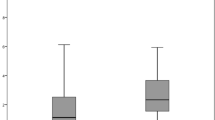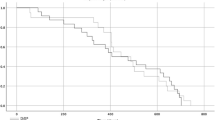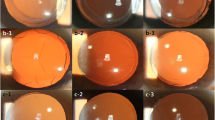Summary
BACKGROUND: After-cataract prompting YAG laser capsulotomy is the most commun complication in cataract surgery. Efforts to reduce it have dominated research during the past years. The various approaches and the advancements made will be reviewed. MATERIALS AND METHODS: Efforts have concentrated on optimizing the inhibiting effect of the optic rim against lens epithelial migration. Generally implementing a sharp posterior edge has drastically reduced the rate of regeneratory after-cataract. Since the mid-90ies the "Vienna Intraocular Lens Study Group" has systematically investigated the impact of optic design and material as well as that of various new implants and techniques in a series of prospectively randomized intraindividual comparison studies using objective evaluation methods. RESULTS AND CONCLUSIONS: Circular rhexis-optic overlap revealed to be essential for the effectiveness of a posterior sharp optic edge. Using haptics with a capsular bag design and a slim optic junction further enhances the performance. Though after-cataract could be drastically reduced, it still cannot be totally avoided due to primary and secondary barrier failures. The effectiveness of capsular bending rings or primary posterior capsulorhexis has also been limited, and did not find general acceptance due to the costs for an additional implant or the demanding surgical technique. Anterior capsule polishing revealed to even increase the need for laser capsulotomy. Eradication of the residual lens epithelial cells by rinsing the sealed capsular bag with toxic agents has appearingly also not been successful. Routine posterior optic buttonholing through a well-centered posterior capsulorhexis opening turns out to be a safe and effective surgical approach by precluding access of lens epithelial cells behind the optic while at the same time avoiding fibrosis of the anterior capsule. As this effect is independent of optic rim design and lens material, future efforts of lens refinement may concentrate on reducing reflectivity of the optic rim and on optimizing biocomaptibility of the lens material.
Zusammenfassung
HINTERGRUND: Der Nachstar ist die häufigste Komplikation nach Kataraktoperationen. Die Bemühungen, die Nachstar- und damit die YAG-Laserkapsulotomierate zu senken, haben die Forschungsanstrengungen der letzten Jahre dominiert. Ansätze und Fortschritte sollen als Überblick dargestellt werden. MATERIAL UND METHODE: Die Anstrengungen haben sich vornehmlich auf die Optimierung der Wirksamkeit der Optikkante als Migrationsbarriere für Linsenepithelzellen konzentriert. Die generelle Einführung der scharfen hinteren Optikkante hat die regeneratorische Nachstarrate drastisch gesenkt. Die "Wiener Studiengruppe für Kunstlinsenimplantation" hat seit Mitte der 90er-Jahre die Auswirkungen von Linsendesign und Linsenmaterial wie auch die neuer Implantate und Techniken in prospektiv randomisierten intraindividuellen Vergleichstudien unter Einsatz objektiver Graduierungs-methoden systematisch untersucht. RESULTATE UND SCHLUSSFOLGERUNGEN: Die zirkuläre Überlappung der Optik erwies sich als Voraussetzung für das Wirksamwerden der scharfen Kante. Durch Haptiken mit kapselsackgerechtem Design und schlanker Optikanbindung und durch Verwendung fibroseinduzierender Optikmaterialien konnte die Effektivität weiter gesteigert werden. Eine wichtige Erkenntnis war, dass der Nachstar dadurch zwar in Häufigkeit und Ausprägung drastisch gesenkt, jedoch nicht gänzlich vermieden werden kann. Alternative Ansätze wie der Kapselknickring und die hintere Kapsulorhexis erwiesen sich auch nur als begrenzt effektiv und unter Berücksichtigung der Kosten für das zusätzliche Implantat und der Schwierigkeit der chirurgischen Technik damit nicht konkurrenzfähig. Die Politur des vorderen Kapselblattes zeigte sich nicht nur als ineffektiv, sondern als kontraproduktiv, indem sie die Laserkapsulotomierate sogar steigerte. Versuche, die Linsenepithelzellen durch toxische Agentien auszuschalten, scheinen trotz der Entwicklung von geschlossenen Spülsystemen nicht zielführend. Vielversprechend ist vielmehr der routinemäßige Einsatz der hinteren Einknöpftechnik: Das Einknöpfen der Linsenoptik in eine wohlzentrierte hintere Kapsulorhexisöffnung macht ein Einwachsen von Linsenepithelzellen hinter die Optik unmöglich und hält das vordere Kapselblatt klar. Da dieser Ansatz vom Optikkantendesign und Linsenmaterial unabhängig ist, können diese nun auf Reflexarmut und Biokompatibilität hin optimiert werden, ohne damit die Nachstarperformance zu beeinträchtigen.
Similar content being viewed by others
Literatur
Agarwal A, Agarwal S, Agarwal A, Maloof A (2003) Sealed-capsule irrigation device. J Cataract Refract Surg 29: 2274–2276
Bhermi GS, Spalton DJ, El-Osta AA, Marshall J (2002) Failure of a discontinuous bend to prevent lens epithelial cell migration in vitro. J Cataract Refract Surg 28: 1256–1261
Davison JA (2004) Neodynium: YAG laser posterior capsulotomy after implantation of AcrySof intraocular lenses. J Cataract Refract Surg 30: 1492–1500
Davison JA (2005) Consultation section. J Cataract Refract Surg 31: 657–658
Findl O, Buehl W, Menapace R, Georgopoulos M, Rainer G, Siegl H, Kaider A, Pinz A (2003) Comparison of 4 methods for quantifying posterior capsule opacification. J Cataract Refract Surg 29: 106–111
Findl O, Menapace R, Sacu S, Buehl W, Rainer G (2005) Effect of optic material on posterior capsule opacification in intraocular lenses with sharp-edge optics: randomized clinical trial. Ophthalmology 112: 67–72
Georgopoulos M, Menapace R, Findl O, Rainer G, Petternel V, Kiss B (2003) After-cataract in adults with primary posterior capsulorhexis: comparison of hydrogel and silicone intraocular lenses with round edges after 2 years. J Cataract Refract Surg 29: 955–960
Greite JH, Kaden P, Kreiner CF, Kain H, Hunold W (1990) "Osmo-Lavage" zur Nachstarverhütung. In: Freyler H, Skorpik CH, Grasl M (Hrsg) 3. Kongress der deutschen Gesellschaft für Intraokularlinsenimplantation. 2.–4. 3. 1989, Wien. Springer, Wien New York, pp 197–207
Grieshaber MC, Pienaar A, Stegman R (2005) Posterior vertical capsulotomy withnoptic entrapment of the intraocular lens in congenital cataracts for prevention of capsular opacification. J Cataract Refract Surg 31: 886–894
Hayashi K, Hayashi H, Nakao F, Hayashi F (1998) In vivo quantitative measurement of posterior capsule opacification after extracapsular cataract surgery. Am J Ophthalmol 125: 837–843
Kappelhof JP, Vrensen GF (1992) The pathology of after-cataract. A minireview. Acta Ophthalmol [Suppl] 205: 13–24
Menapace R (2004) Prevention of PCO. In: Kohnen T, Koch DD (eds) Cataract and refractive surgery, essentials in ophthalmology. Springer, Berlin Heidelberg New York, pp 101–122
Menapace R, Wirtitsch M, Findl O, Buehl W, Kriechbaum K, Sacu S (2005) Effect of anterior capsule-polishing on posterior capsular opacification and Neodymium-YAG capsulotomy rate: a three-year randomized trial. J Cataract Refract Surg 31: 2067–2075
Menapace R (2006) Routine "Posterior Optic buttonholing" for eradication posterior capsule opacification in adults: report of 500 consecutive cases. J Cataract Refract Surg 32: 929–943
Menapace R, Di Nardo S (2006) "Aspiration Curette": An instrument for efficient and safe anterior capsule polishing: laboratory and clinical performance. J Cataract Refract Surg 32: 1997–2003
Nagamoto T, Fujiwara T (2003) Inhibition of lens epithelial cell migration at the intraocular lens optic edge: role of capsule bending and contact pressure. J Cataract Refract Surg 29: 1605–1612
Nishi O, Nishi K, Sakanishi K (1998) Inhibition of migrating lens epithelial cells at the capsular bend created by the rectangular optic edge of a posterior chamber intraocular lens. Ophthalmic Surg Lasers 29: 587–594
Nishi O, Nishi K (1999) Preventing posterior capsule opacification by creating a discontinuous sharp bend in the capsule. J Cataract Refract Surg 25: 521–526
Nishi O, Nishi K, Akura J, Nagata T (2001) Effect of round-edged Akrylic intraocular lenses on preventing posterior capsule opacification. J Cataract Refract Surg 27: 608–613
Nishi O, Nishi K, Menapace R, Akura J (2001) Capsular bending ring to prevent posterior capsule opacification: 2 year follow-up. J Cataract Refract Surg 27: 1359–1365
Olson RJ (2005) Consultation section. J Cataract Refract Surg 31: 653–654
Prosdocimo G, Tassinari G, Sala M, Di Biase A, Toschi PG, Gismondi M, Corbanese U (2003) PCO after phacoemulsification: silicone CeeOn Edge versus Akrylate AcrySof IOL. J Cataract Refract Surg 29: 1551–1555
Author information
Authors and Affiliations
Corresponding author
Rights and permissions
About this article
Cite this article
Menapace, R. Nachstarprophylaxe – Ein gelöstes Problem?. Spektrum Augenheilkd. 21, 166–178 (2007). https://doi.org/10.1007/s00717-007-0205-1
Issue Date:
DOI: https://doi.org/10.1007/s00717-007-0205-1
Key words
- Posterior capsule opacification and laser capsulotomy
- Regeneratory and fibrotic after-cataract
- Migration barrier
- Lens material and design
- Capsular surgery
- Sharp optic edge
- Rhexis-optic overlap
- Fibrotic potential
- Capsular bending ring
- Primary posterior capsulorhexis
- Sealed capsule irrigation
- Primary posterior optic buttonholing
Schlüsselwörter
- Hintere Kapseltrübung und Laserkapsulotomie
- Regeneratorischer und fibrotischer Nachstar
- Migrationsbarriere
- Linsenmaterial und Linsendesign
- Kapselchirurgie
- Scharfkantige Optik
- Rhexis-Optik-Überlappung
- Fibrosepotential
- Kapselknickring
- Primäre hintere Kapsulorhexis
- Kapselsackspülung im geschlossenen System
- Hintere Einknöpftechnik




